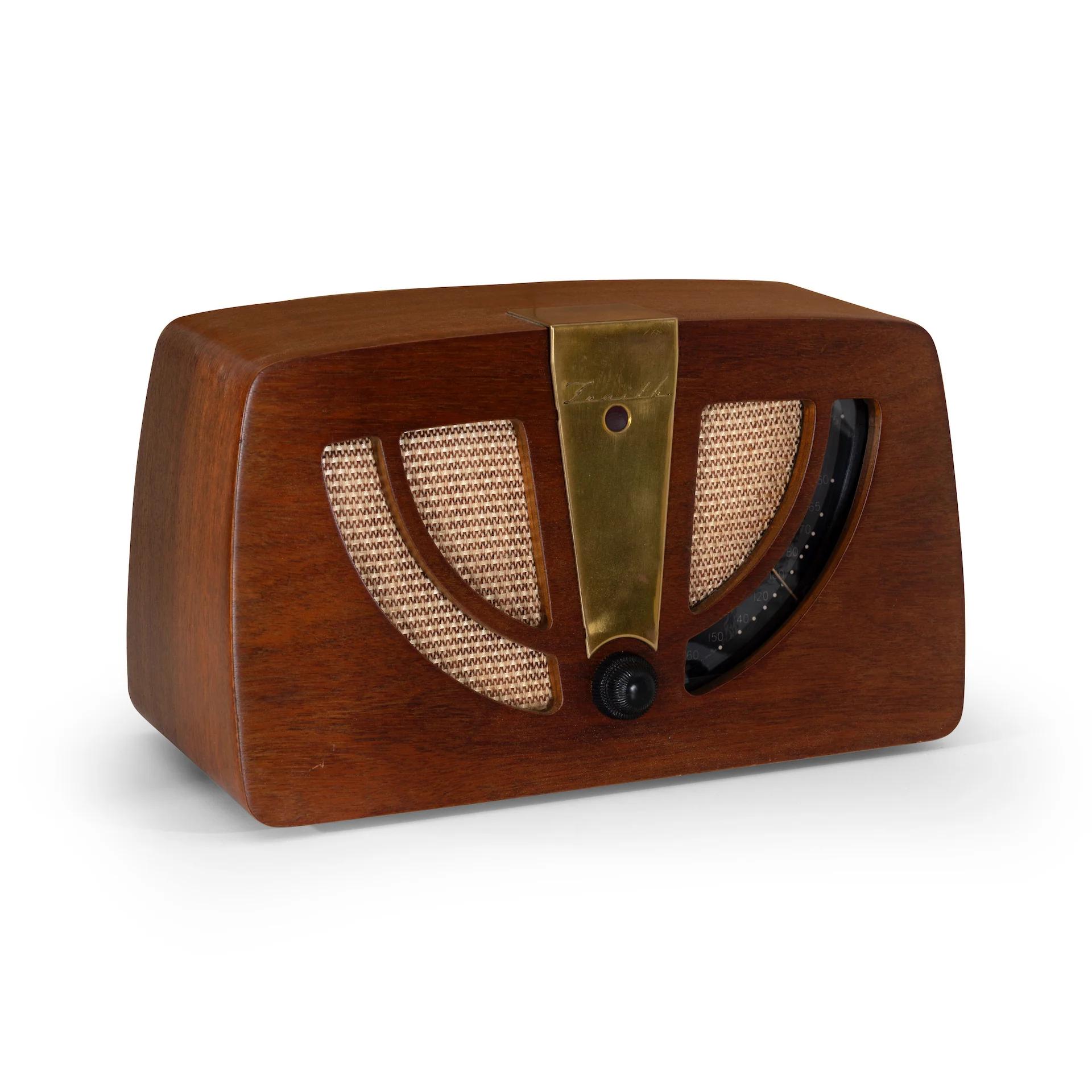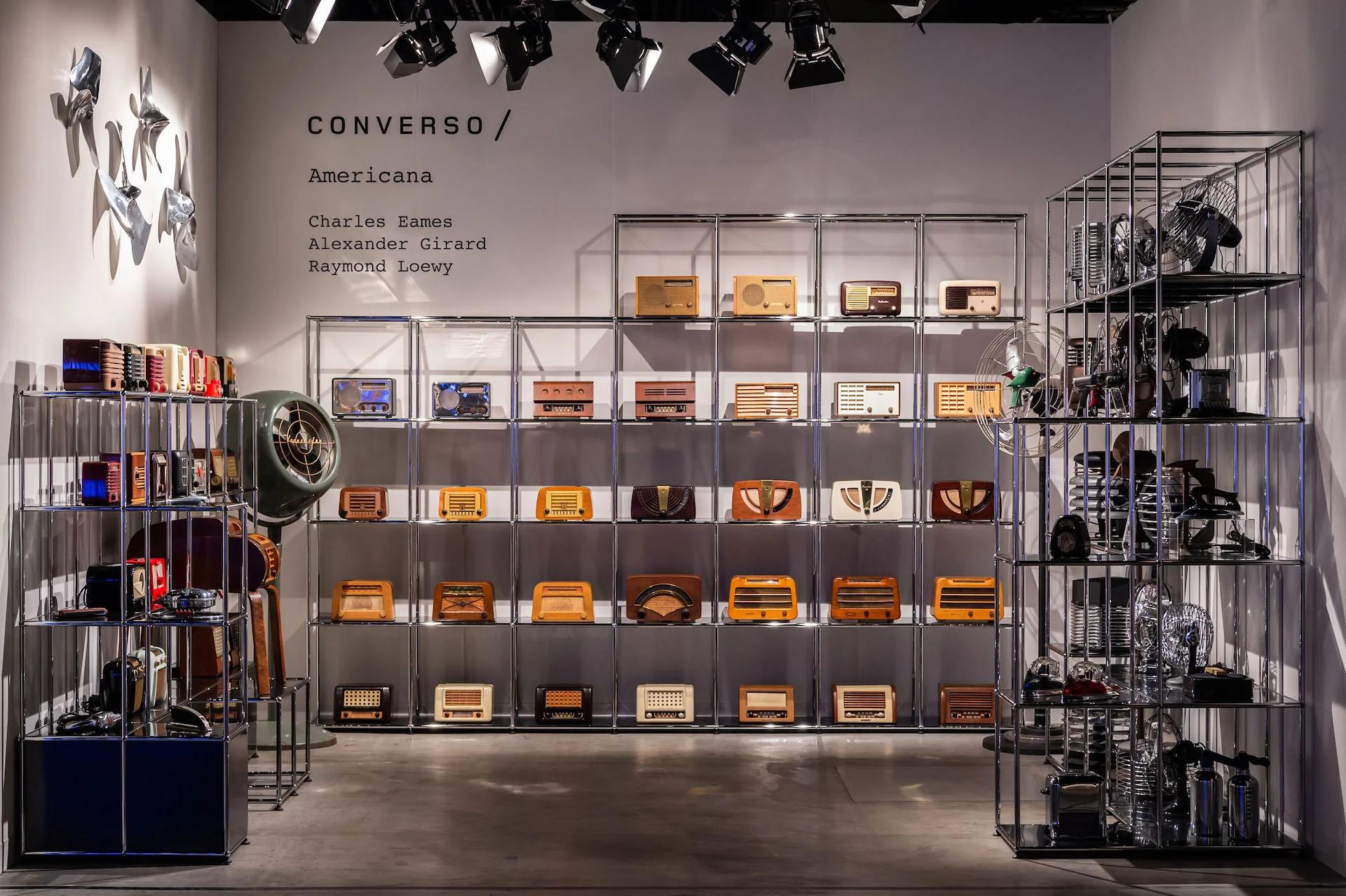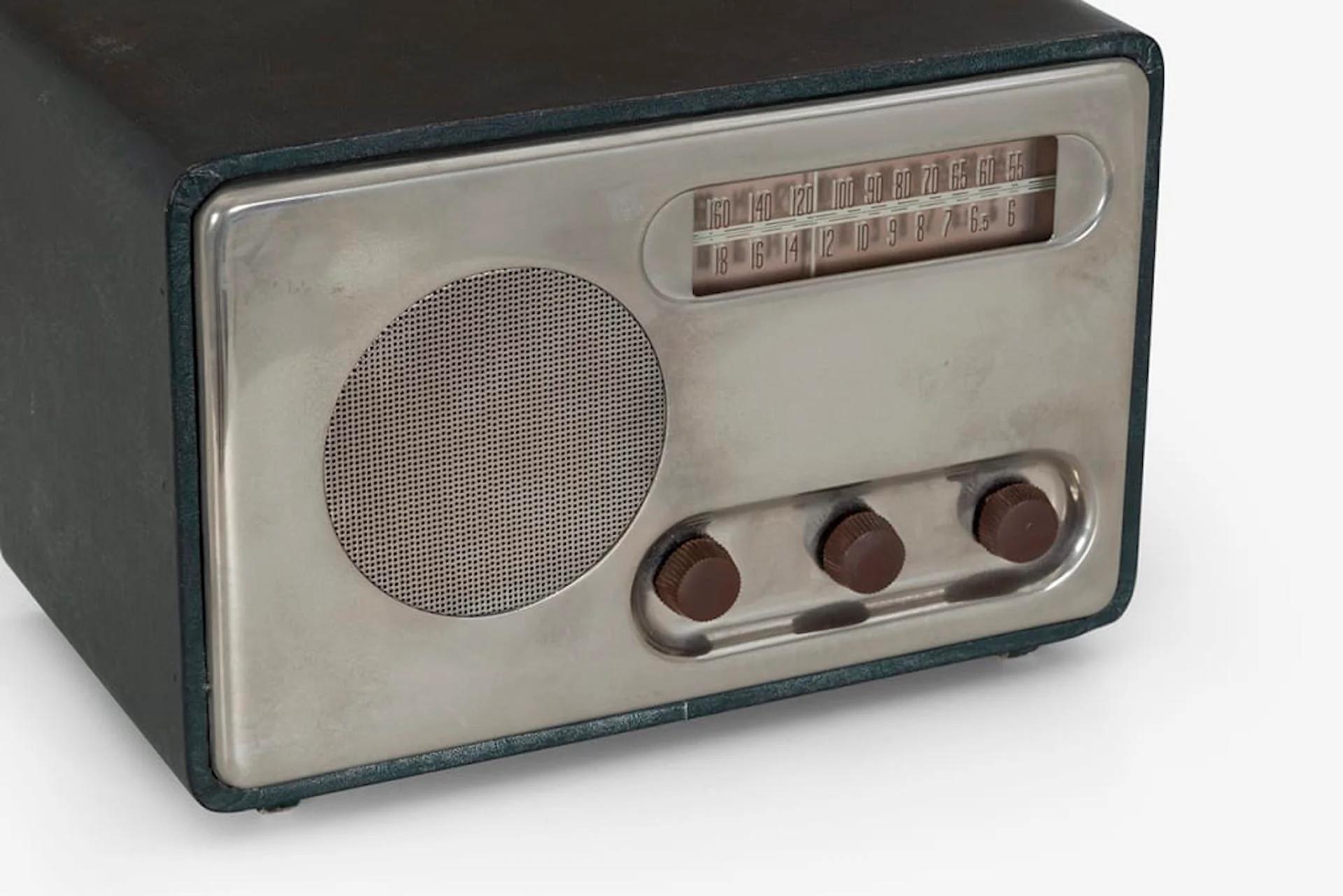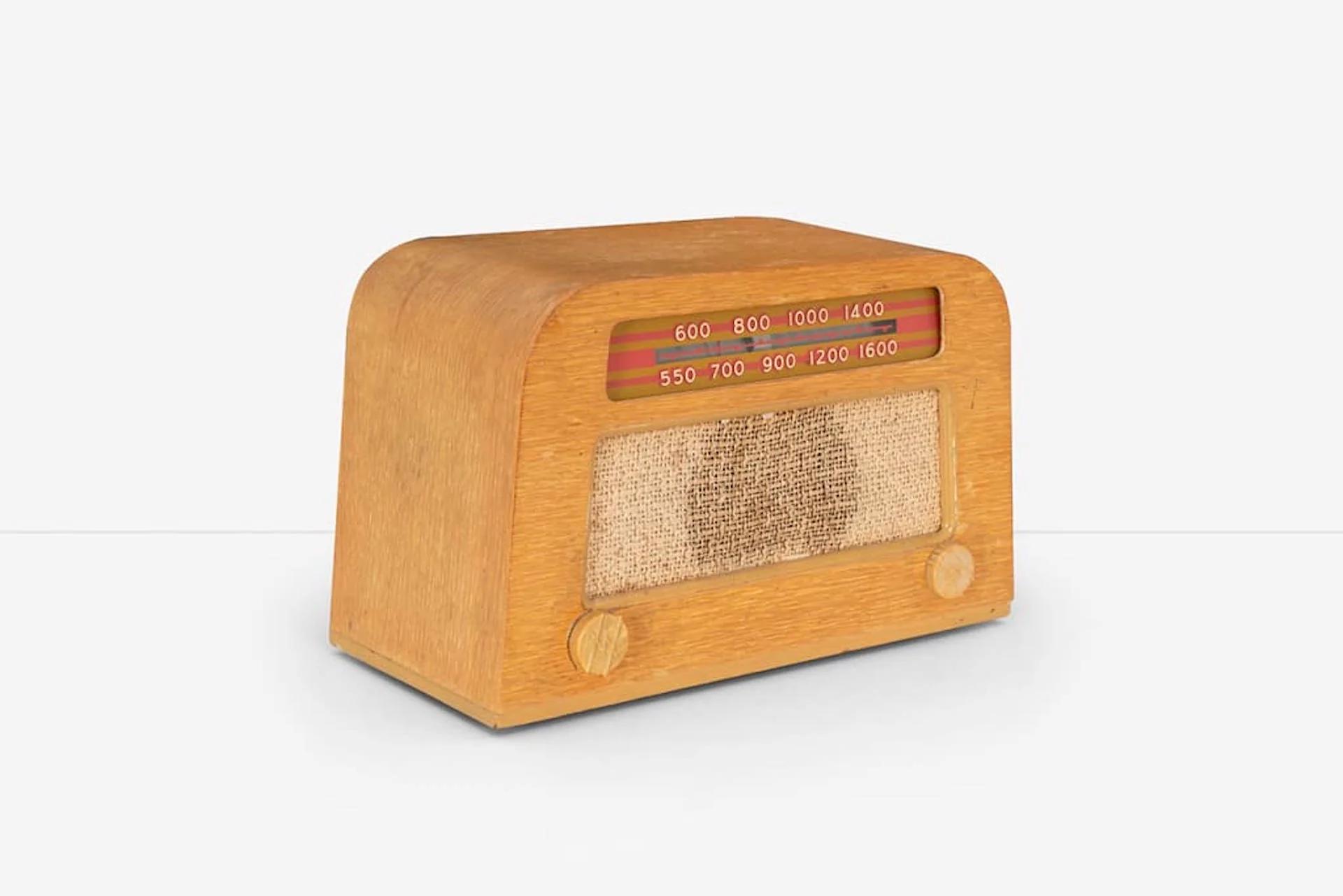MASTERPIECES DECEMBER 7 2021
by Design Miami
Lawrence Converso shares the fascinating story behind a rare collection of mid-century American industrial design

CHARLES & RAY EAMES FOR ZENITH/ MODEL 6D030Z TUBE RADIO IN LIGHT MAHOGANY MOLDED PLYWOOD CASE, 1946
Photo © Converso Gallery
Known and loved for bringing to light historical works that have been overlooked by both scholarship and markets, Chicago’s Converso Gallery recently unearthed a significant, highly researched collection of industrial design objects produced in the U.S. in the World War II era.
Encompassing radios, fans, and more—most designed by American design powerhouses like Charles and Ray Eames, Alexander Girard, and Raymond Loewy—this Americana collection, as it has been dubbed, encapsulates that vital moment of transition in American history when the high-tech became commonplace in everyday homes.
Encountering something so special, we just had to learn more. What follows is Lawrence Converso’s account of the history behind the Americana collection.

CONVERSO'S AMERICAN EXHIBITION AS DESIGN MIAMI/ BASEL LAST SEPTEMBER
Photo © World Red Eye
Americana is a very intentional collection with three key sections put together over several decades.The heart of it is a radio study collection that looks at a fairly unaddressed, marginalized moment in the career of Ray and Charles Eames, right before their very famous Herman Miller collaboration really exploded. This was an approximately two-year period from 1945 to 1947 while they were still in Venice, California—after they had perfected the compound molding of plywood as a subcontractor for the Federal government, in which they produced splints and aerospace components while working at the Molded Plywood Division of Evans Products Company.
At the time, war rationing had taken away radio manufacturers' favored, cheap casing material: various forms of pressed early plastics like Bakelite and Plaskon. As a war contractor, Evans had access to abundant stands of Oregon lumber and could offer the new Eames molded plywood process to major radio manufacturers as a substitute for pressed plastic. The Eameses went on to produce tens of thousands of radio casings on their Shazam presses in Venice for at least 45 models for major radio manufacturers—Zenith, Hoffman, Tele-Tone, etc.—over the next couple of years. This was arguably the most commercially successful endeavor they ever attempted.

EVANS EAMES SLOTTED/ RAY AND CHARLES EAMES, 1946
Photo © Converso Gallery
The Americana collection includes a comprehensive series of various Eames radio models from several of the most noted manufacturers, for example, Zenith, which continued the Eameses’ designed production the longest, including the first AM/FM radio. The duo’s exploration of molded plywood for radio casings was supposedly initiated by a semi-legendary encounter with Alexander Girard, who was working as the Design Director of Detrola during the war. (The Eameses would actually hire Girard for Herman Miller from his position at Detrola several years later, making design history.)
Under Girard’s direction, Detrola was producing radios for the military in restricted materials like stainless steel, along with ship control panels, bomb detection technologies, and more. The Eameses especially noted the production of radio casings in wood, though without the sophistication and efficiency of the molded plywood processes in use at Venice. The Americana collection explores these connections through an extensive selection of Girard-designed radios for Detrola in wood, steel, and plastics.

DETROLA MODEL #568 GREEN VINYL CASE (MILITARY ISSUE), 1946
Photo © Converso Gallery
To touch on the wider context, the collection also looks at the much simpler wood casings from Raymond Loewy for Emerson, produced during this same period, as well as later bakelite Loewy Emerson models. Radios in plastics from popular manufacturers like Philco, Crosby, Motorola, Bendix, and others both before and after this period of plywood production are included for contrasting context. When war restrictions eased and cheaper, brightly colored plastics were once more available, plywood radio production ceased.
The second, really surprisingly beautiful section of Americana is a collection of industrial fans that date from the early 1930s to the 1950s—mostly table models, some standing models, and even typologies that have since disappeared, such as the hassock fan that sat on the floor and generated air in every direction while functioning as a stool. Americana tracks the development of aeronautical engineering as it influences new electric domestic technologies; the improving sophistication of engine propellers and the science of how to move air effectively went right into domestic fan production. The seriousness of the engineering is reflected in the design and production of the objects. They are what we would today call over-designed, produced at the level of cars, something perhaps totally surprising to us now.

RAYMOND LOWEY LUCITE SALESMAN SAMPLE ATOM CLOCK/RADIO, 1952
Photo © Converso Gallery
Americana also includes unique, innovative technological projects from the 1933 World’s Fair by General Electric, like an unfamiliar wooden caged fan, The Imperial Rochester, which has found its way as a prop into major Hollywood movies, alongside rare and sought-after examples by Airmaster, Seebreeze, Zephyrs by Edgar Ward, and even fans made in jet engine factories of Wichita by Vornado that utilize jet-propulsion technologies.
The third part of Americana is a rigorous but more general collection of industrial design objects for domestic use from the 1930s to the 1950s, objects that are fairly well known from major museum collections like the Cooper Hewitt and the V & A. Isamu Noguchi’s first product, the Hawkeye Timer, is included alongside the Petitpoint Iron, streamlined staplers, important toasters, harmonicas, barware, and even Buck Rogers and Flash Gordon Ray Guns that influence the development of early electric hand held drills.

BENDIX BROWN PLASKON, 1949
Photo © Converso Gallery
Americana gives important insight and perspective into the histories of our material culture on several levels. We are far enough removed from the period that we can approach the objects as foreign and strange. Made in America is an abstract slogan until you’re confronted with the real weight and solidity of these very serious objects, many executed in steel and iron. When you realize a fan cage was welded, then polished, then taped, and then partially bronzed, you realize the commitment and authenticity that went into the production of these products—a far cry from the immateriality of the digital.
The collection also reminds us very directly of the cyclical, imitative nature of industrial culture. Very literally, the electrical grid was laid down and, initially, the same companies who laid the grid generated the appliances that used the electricity. The process repeats with the internet, and the language even catches the repetition: electric appliances model digital apps. In the case of radio broadcasting, the role of the U.S. government in “gifting” the technology to private companies, creating vast monopolies with huge reach is remarkably similar to the more recent governmental role in the creation and formation of the Internet. We are facing our own contemporary struggles with our digital monopolies.

RAY AND CHARLES EAMES MISSION BELL IN COMBED OAK
Photo © Converso Gallery
Finally, some contemporary design historians, like Talia Shabtay, are thinking about how technologies that are foundational to computing and the digital era—like solid core memory processing—came out of the laboratories of the tube radio manufacturers as they strove to make tube technology more efficient. That the Eameses were most likely tracking these developments as they produced molded plywood cases for those same manufacturers puts a whole different context around their subsequent work for IBM. This “marginal” period suddenly becomes quite interesting and from our perspective, quite “central.” ◆

